
The national emblem of Cape Verde contains a circle within which is written the name of the nation in Portuguese. Within the circle are a torch and triangle, symbols of freedom and national unity. At the top of the shield is a plumbob, a symbol of righteousness; three chain links are at the bottom. This emblem replaces the earlier variant with the seashell that had been in use since independence. The current emblem was adopted in 1992.
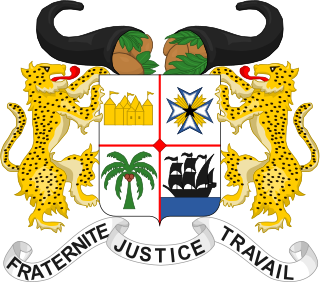
The coat of arms or national seal of Benin, originally introduced in 1964, was readopted in 1990 after being replaced in 1975.

The coat of arms of Bosnia and Herzegovina was adopted in 1998, replacing the previous design that had been in use since 1992 when Bosnia and Herzegovina gained independence. It follows the design of the national flag. The three pointed shield is used to symbolize the three major ethnic groups of Bosnia, as well as allude to the shape of the country.

The coat of arms of Chad was adopted in 1970. The center has a shield with jagged blue and yellow lines, with a sun rising over it. The shield is supported by a goat and a lion. Below the shield is a medal and a scroll with the national motto in French, Unité, Travail, Progrès. The shield supporters as well as the scroll feature a red arrow pointing upwards.

The national emblem of the Democratic Republic of the Congo has changed several times since 1997. The current one was introduced in 2006 and depicts a leopard head, surrounded by an elephant tusk to the left and a spear to the right. Below are the three words which make up the national motto: Justice, Paix, Travail. It was adopted on 18 February 2006 by President Joseph Kabila.
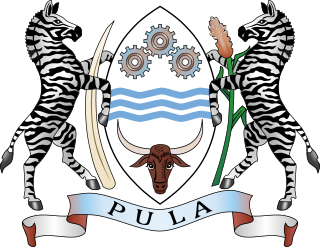
The coat of arms of Botswana was adopted on 25 January 1966. The centre shield is supported by two zebras. The shape of the shield is that of traditional shields found in Southern Africa. On the top portion of the shield are three cogwheels that represent industry.

Every sultan of the Ottoman Empire had his own monogram, called the tughra, which served as a royal symbol. A coat of arms in the European heraldic sense was created in the late 19th century. Hampton Court requested from the Ottoman Empire a coat of arms to be included in their collection. As the coat of arms had not been previously used in the Ottoman Empire, it was designed following this request, and the final design was adopted by Sultan Abdul Hamid II on 17 April 1882.

The coat of arms of Romania was adopted in the Romanian Parliament on 10 September 1992 as a representative coat of arms for Romania. The current coat of arms is based on the lesser coat of arms of interwar Kingdom of Romania, which was designed in 1921 by the Transylvanian Hungarian heraldist József Sebestyén from Cluj, at the request of King Ferdinand I of Romania, it was redesigned by Victor Dima. As a central element, it shows a golden aquila holding a cross in its beak, and a mace and a sword in its claws. It also consists of the three colors which represent the colors of the national flag. The coat of arms was augmented on 11 July 2016 to add a representation of the Steel Crown of Romania.

The National emblem of Mongolia is used by the government of Mongolia as its symbol of state. It is officially used for example on documents such as Mongolian passports, and government and embassy placards.

The state emblem of Uzbekistan was formally adopted on July 2, 1992 by the newly establish Republic of Uzbekistan. It bears many similarities to the emblem of the previous Uzbek SSR, which Republic of Uzbekistan succeeded. Like other post-Soviet republics whose symbols do not predate the October Revolution, the current emblem retains some components of the Soviet one. Prior to 1992, Uzbekistan had an emblem similar to all other Soviet Republics, with standard communist emblems and insignia.

The first coat of arms of Montreal was designed by Jacques Viger, the first mayor of Montreal, and adopted in 1833 by the city councillors. Modifications were made some one hundred five years later and adopted on 21 March 1938, and again on 13 September 2017, resulting in the version currently in use. The coat of arms was the only city emblem representing Montreal until 1981, when a stylized logo was developed for common daily use, reserving the coat of arms for ceremonial occasions.

The national emblem of Indonesia is called Garuda Pancasila. The main part is the Garuda with a heraldic shield on its chest and a scroll gripped by its legs. The shield's five emblems represent Pancasila, the five principles of Indonesia's national ideology. The Garuda claws gripping a white ribbon scroll inscribed with the national motto Bhinneka Tunggal Ika written in black text, which can be loosely translated as "Unity in Diversity". Garuda Pancasila was designed by Sultan Hamid II from Pontianak, supervised by Sukarno, and was adopted as the national emblem on 11 February 1950.
Abkhazia is a region in the Caucasus that is under the effective control of the partially recognised self-declared Republic of Abkhazia. The de jure majority internationally recognized Autonomous Republic of Abkhazia claims to be its legitimate government.

The national emblem of East Timor is one of the national symbols of East Timor.
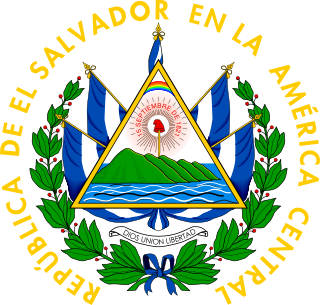
The coat of arms of El Salvador has been in use in its current form since 15 September 1912.
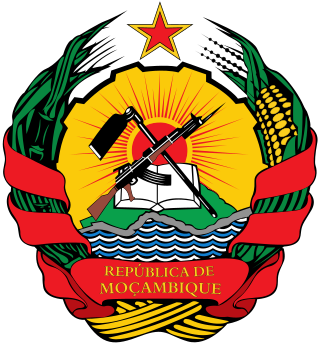
The national emblem of Mozambique was adopted in 1990 in the Constitution of Mozambique article 194. The article clearly states the design and meaning of the device. It shows a gear wheel, bordered by corn stalks and sugarcane. In the middle there is a red sun over a map of Mozambique in green, and blue waves, an AK-47 crossed with a hoe, and a book. The wreath is tied with a ribbon bearing the name of the country. The emblem is rendered in a socialist heraldry style similar to those used by the republics of the Soviet Union.
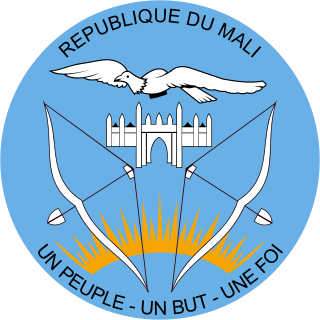
The emblem of Mali is a national emblem consisting of a circle charged with a bird at the top, a mosque in the centre flanked by two bows and arrows, and the rising sun at the bottom. Adopted thirteen years after the country gained independence, it has been the seal of the Republic of Mali since 1973. It is utilized on official documents as a coat of arms.

The national emblem of Sri Lanka is used by the State of Sri Lanka and the Sri Lankan government in connection with the administration and government of the country. The current emblem has been in use since 1972 and created under the ideas and guidance of Nissanka Wijeyeratne. At the time, he was Permanent Secretary to the Ministry of Cultural Affairs and Chairman of the National Emblem and Flag Design Committee. The designer of the emblem was Venerable Mapalagama Wipulasara Maha Thera, and the artwork was by S. M. Seneviratne.

The imperial coat of arms of the Central African Empire consists of a shield in the centre, with two flags on its edges, and with a sun rising over the shield, with an imperial eagle in the centre. With the imperial crown of Bokassa I above, below and above the shield are banners, and there is a medal located below the shield as well.
A national coat of arms is a symbol which denotes an independent state in the form of a heraldic achievement. While a national flag is usually used by the population at large and is flown outside and on ships, a national coat of arms is normally considered a symbol of the government or the head of state personally and tends to be used in print, on armorial ware, and as a wall decoration in official buildings. The royal arms of a monarchy, which may be identical to the national arms, are sometimes described as arms of dominion or arms of sovereignty.





















